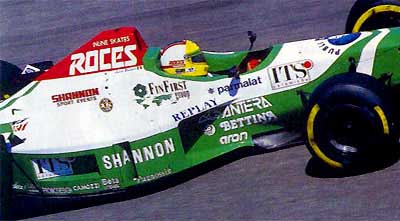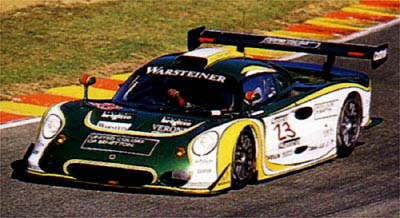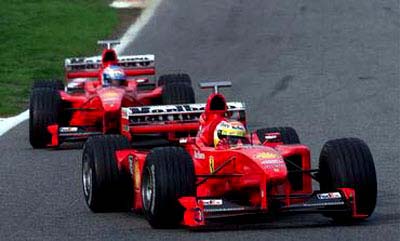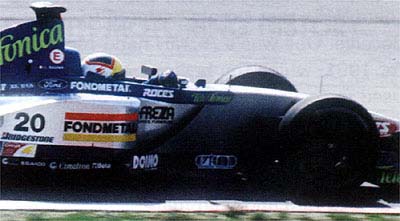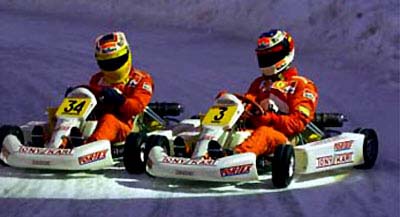| 1985-88
Luckless Luca a consistent winner in karting classes |
Statistically, Italian driver Luca
Badoer, born on 25 January 1971
in Montebelluna, the son of wealthy parents, ranks as the driver with the
most number of F1 races under his belt without scoring a single point.
Result-wise, his resume does look rather sad. But you don't walk off with
the F3000 title at your first attempt, and secure the most prestigious
tester's role in F1 with Ferrari, without having quite a bit of talent. If
you thought Johnny Herbert had all the bad luck, spare a thought
for Luca Badoer.
Starting off his racing career in the hurly-burly of Italian karts, he first competed in 1985, and in his rookie year scored two wins. In 1986, driving in the 100cc category, he became champion of Venice, and the next year was overall Italian champion for that class. Moving up in 1988 to the Super-100cc and International classes, he once again became Italian champion in his Birel/Sirio. | |
| 1989-91
Suspicious F3 successes follow stunning serves of talent |
Now it was time to move up, and Badoer made the transition straight
into Italian F3. A learning year in 1989 in the Trivellato team, using a
Dallara/Alfa Romeo, was followed by a move to the MDR team in 1990. At the
age of nineteen, he stunned the establishment when, in the last round at
Vallelunga, he beat championship contenders Roberto Colciago and Alessandro
Zanardi to record his first victory in car racing.
Badoer was now considered a genuine contender for the Italian F3 title in 1991 when he changed to the Supercars team. After a slow start, he suddenly reeled off four wins in succession, and rival teams became suspicious. Indeed, the fourth of those wins was eventually scrubbed because his car was using non-scrutineered tyres. Perhaps justifying his rivals' suspicions, Badoer's season fell away after that, and he only managed to finish 4th overall. | |
|
| ||
| 1992
Takes it to the big names in F3000 with amazing early form |
But it was enough to promote Badoer into F3000 in 1992 with the
Crypton team, using a Reynard 92D with a Cosworth engine, as team-mate to
1991 Lotus driver Michael Bartels. Against a
host of future F1 drivers, including Rubens Barrichello,
Olivier
Panis, David Coulthard,
Andrea
Montermini, Jean-Marc
Gounon and Emanuele
Naspetti, Badoer found his feet early, and reeled off a 5th and two
6th places in his first three races.
Then, amazingly, at Enna and Hockenheim he completely dominated the opposition, taking pole, fastest lap and the race win. He then backed that up with another victory at the Nurburgring. | |
| 1992-93
Wins the Championship at first attempt, heads to F1 |
It was only at Spa, when a huge accident at Eau Rouge split his
driving helmet and left him in hospital overnight, that he came back down
to earth after such an incredible string of results. Bouncing back at
once, he came second to Montermini at Albacete, and then took another
trifecta of pole, fastest lap and victory at Nogaro to clinch the title at
his very first attempt, thank you very much.
Despite not scoring in the final round at Magny-Cours, Badoer still took the title by 12 points over Montermini, and 19 points over Barrichello. By the end of 1992 both Badoer and Barrichello had F1 contracts for 1993 in their back-pockets, but from there their fortunes would reverse dramatically. | |
|
| ||
| 1993
Eric Broadly joins with BMS Scuderia Italia, chassis possibly promising |
While Barrichello found himself at Jordan, starred in the rain at
Donington and scored his first points in Japan, Badoer joined the BMS
Scuderia Italia team, which had used the Dallara chassis from 1988 to
1992. In 1992, using Ferrari engines, in the hands of JJ Lehto and
Pierluigi Martini the Dallaras had proven capable midfield runners,
but the car was incapable of any meaningful development. By the end of the
year, Scuderia Italia and Dallara had parted company.
On the other hand, Eric Broadley's Lola concern had tried to succeed in F1 on numerous previous occasions, such as with the Carl Haas Beatrice team in 1985-6, and with Larrousse from 1987 to 1991. After Larrousse dumped Lola in favour of the Venturi chassis in 1992, Broadley regrouped, and for 1993 linked up with Scuderia Italia. On paper, it looked a decent combination. With undeniable pedigree in Indy car racing, the Lola T93/30 chassis should have been a good one. | |
| 1993 Lola The young and the ageless combine for a neanderthal season |
Despite the fact that the Ferrari customer engines were getting
old, they were still powerful. Apart from the money pumped in by Italian
magnate Beppe Lucchini, the team found sponsorship from
Chesterfield. In the driving department, there was the combination of the
young charger (Badoer) and the experienced hand in Michele
Alboreto, who had just enjoyed a fine season with Footwork in 1992.
Instead, for the team with the longest name in pitlane (officially Lola
BMS Scuderia Italia), the year would prove to be an utter disaster, and
the cars were at the rock bottom of the grid.
Compared with the technology employed by other teams, the stock-standard Lola was prehistoric. It was hardly an atmosphere in which Badoer could learn his trade, and it would only be fair for us to compare his results with Alboreto's, to show what Badoer did in fact achieve. | |
|
| ||
| 1993
New rules cause Lolas difficulties, misses a point at Imola |
For his debut in South Africa, Badoer found the going very tough.
The Lolas filled the back row, with Alboreto some 6.2s off Alain Prost on pole, and Badoer some 9s off the
Frenchman. Gearbox problems forced Badoer out after 20 laps. Then in
Brazil, a new rule was introduced whereby the 26th fastest in qualifying
would not make the grid. Badoer got in comfortably in 21st, ahead of both
Tyrrells and Fabrizio
Barbazza's Minardi, while Alboreto just beat Ivan Capelli's
Jordan for the last grid spot.
After a pit stop for a new nosecone, Badoer finished 12th and last, just behind Alboreto, and 3 laps down. At Donington, Badoer fell victim to the new rule when he was just 0.2s off Andrea de Cesaris' Tyrrell in 25th spot. Then at Imola, Alboreto was the man who missed the cut, while Badoer was 24th ahead of Barbazza. But in a race of attrition, while the Minardi came 6th to score a point, Badoer was tantalisingly close in 7th, 3 laps down. This 7th would end up being his best result in F1. | |
| 1993
FIA farce ruling makes the Lolas temporarily the only legal cars on the grid |
In Spain, Badoer once again outqualified Barbazza and the Tyrrells,
and was 1.1s faster than Alboreto, but he retired just after halfway.
Monaco was a shocker, where Badoer was last by miles having lapped at over
9s slower than Prost, but in Canada he beat Alboreto to the last spot by
0.025s and finished 15th.
Just prior to the Canadian race, the FIA had outlawed all electronic devices such as traction control and active suspension, effective immediately, which caused an uproar from just about every team, since only the Lolas didn't have any gizmos at all - another indication of how far behind other teams they were. Thanks to Tom Prankerd, we know that at one stage, it looked as though the Lolas would be the only legal cars in Montreal, but the FIA relented and the devices would only be banned at the end of the year. | |
|
| ||
| 1993
Consistently outperforms Alboreto, but reliability proves a downfall |
In France, Badoer outqualified both Minardis and De Cesaris, while
Alboreto was left on the sidelines again. Britain also saw Badoer beat
Alboreto for the last spot by 0.3s. At Hockenheim he was a full second
faster than Alboreto (despite a set of four accidents throughout the whole
weekend), but by now all 26 were allowed to start again. This meant Badoer
did race in Hungary, although he was slower than his team-mate by 1.1s.
But in all four of these races he failed to finish, twice due to suspension failures. At Spa, Badoer was once again a second up on Alboreto, and came home 13th. By now the Lolas were finally getting some reliability, and in Italy, having started 25th, Badoer ran ahead of Christian Fittipaldi (who eventually flipped over the line in 8th) before dropping back to finish 10th. | |
| 1993-94
Poor Benetton test leaves Luca with limited testing duties for Minardi |
Then in Portugal, Badoer started last and finished 14th out of the
16 classified, but he was the final car running. After Estoril, seeing
what a complete waste of effort the whole operation was, the team folded,
and Scuderia Italia announced it would be joining forces with Minardi in
1994. Incredibly, if you think about it, Benetton had both Alboreto and
Badoer in their sights for 1994 as team-mate to Michael Schumacher, but in the end they plumped for
Lehto after both Italians disappointed in tests.
Alboreto found his way into the Minardi line-up instead, while Badoer got himself a very limited testing role with the same team. But if you consider their relative performances throughout 1993, there was no justice in that. | |
|
| ||
| 1995 Minardi Gruntless engine hinders performance, Martini gives way for cash |
But come 1995, Alboreto had retired from F1, and Badoer was
promoted into the Minardi race team alongside Martini. It was a case of
being in the wrong place at the wrong time, for Minardi had just had a
Mugen Honda engine deal snatched from under its nose by Ligier. With the
Japanese engine the M195 chassis would have been dynamite, but instead the
Italian team had to settle for the powerless Ford ED V8s.
Badoer generally qualified in the lower midfield (six times he started 18th, and only once did he miss the top 20), and was fairly evenly matched with his team-mate. On tighter tracks, though, where the Minardi's power deficiency didn't matter as much, Badoer put in some marvellous performances to ensure that at mid-season, when the team was really starting to run out of cash, it was their stalwart Martini who had to give way to pay-driver Pedro Lamy. | |
| 1995
Makes life difficult for those lapping him, more pointless lowly finishes |
But on the whole, after a year on the sidelines Badoer was usually
pretty average, and his manners while being lapped didn't win him any
friends. He started the year with a gearbox failure in Brazil, and in the
wet qualifying in Argentina he scored a mighty 13th spot. But at the first
corner, when Jean Alesi
spun, Badoer clouted the back of Mika
Salo's Tyrrell, and later around the lap smashed into Barrichello's
Jordan as well. The red flags came out, and without a spare chassis in the
garage Badoer did not start the restarted race.
His repulsive mobile chicane antics in Imola ended with a 14th place finish, but he retired in Spain and Monaco, before reeling off an 8th, 13th and 10th in Canada, France and Britain. In Germany he had more gearbox problems, before finishing 8th in Hungary (where he had started a fabulous 12th) and spinning off in Belgium. | |
|
| ||
| 1995
Sends the Kat into orbit, but comes back to earth when dumped for point scorer Lamy |
The next two races he'd rather forget, I think. At Monza, he had a
huge practice accident that saw him overturn his car. Then at the first
start, Massimiliano Papis spun right in front
of him, triggering a multi-car pile-up, but Badoer just managed to avoid
the Arrows. It mattered little, because he crashed after 26 laps anyway.
Then at Estoril, his was the car Ukyo Katayama clipped before
flipping wildly mid-air seconds after the start. A shaken Badoer took the
restart in his spare and came 14th.
11th at the Nurburgring was followed by 15th and 9th in the two Japanese races, but having qualified 15th in Adelaide, he failed to start after electrical problems hit just before the race. In that race, Lamy scored a precious point for Minardi, and come 1996 the Portuguese driver was the one retained, while Badoer was dumped, seemingly in favour of cashman Taki Inoue (though eventually Giancarlo Fisichella and others got the drive). | |
| 1996 Forti Corse Signs up with minnows to do battle with new 107% qualifying rule |
On the seat of his pants, Badoer threw in his lot with cellar
dwellers Forti for 1996 as team-mate to former F3000 sparring partner Andrea
Montermini. Here was a team struggling for money after Pedro
Diniz had left for Ligier, and despite fitting a Ford Zetec R V8
engine into a revised 1995 chassis, the new 107% qualifying rule was a
tall order for both Italian drivers as they waited for the new FG03
chassis to arrive.
Though Badoer would easily have the upper hand over Montermini, both were miles off making the cut in Melbourne, but at Interlagos Badoer started 19th after both Diniz and Tarso Marques recorded no time (but were allowed to start anyway). Badoer limped home in the rain, 4 laps down, in 11th. Then in Argentina, he started 21st, but tangled with Diniz in the race. | |
|
| ||
| 1996
Upturned and left for dead in Buenos Aires, suspended ban after Monaco |
The result was an upturned Forti in the gravel. Astonishingly, the
inept Argentine marshals refused to come near the car for fear of who
knows what, and Badoer spent agonising moments freeing himself from the
car. When finally one marshal reluctantly offered an arm to help, in sheer
frustration (who could blame him?) Badoer shoved him aside. The European
GP was a lost cause as the team looked forward to the impending new car,
and neither driver qualified.
At Imola, only Badoer had the new car, and Luca proceeded to go faster than Montermini by 1.6s, making the grid whilst Andrea missed out. In the race, Badoer came home a fine 10th, albeit the last of the runners. Then in the demolition derby at Monaco, Badoer dawdled around at the back before chopping across Jacques Villeneuve's Williams at the Mirabeau, putting both cars out. For that, Badoer earned himself a nice suspended one-race ban. | |
| 1996
Dwindling finances cause trouble, eventually lead to premature closure |
Neither Forti made the cut in Spain, but in Canada, Badoer actually
managed to outqualify Ricardo
Rosset's Footwork, starting 20th before retiring with gearbox
problems. By this stage Forti had attracted sponsorship from the
mysterious Shannon Group, and it was hoped that an injection of funds
would help the team move up the ranks, as it was obvious that the FG03 was
an OK car, which could become competitive with some development.
Unfortunately, the Shannon Group never paid up, despite having actually taken tight control over the team. In France, Badoer got off the last row only after Eddie Irvine was relegated to the back, but retired with fuel pump problems. In Britain neither car qualified, and by the time the teams got to Hockenheim, Forti was out of money and in dire straits. The cars didn't venture out onto the circuit, and the team folded immediately, leaving Badoer in the lurch. | |
|
| ||
| 1997
Dabbles in a bit of mediocre GT racing with Mimmo |
Once again, Badoer's talent was left to waste, and in 1997 he had
virtually nothing on his plate. He only managed to secure himself six
outings in the FIA GT championship, driving both a GBF Engineering Lotus
Elise Turbo, and a Lotus Elise GT1. It was all a time-passing exercise, as
the cars were not very competitive at all.
At Hockenheim and Silverstone, sharing the car with Mimmo Schiattarella and Mauro Martini, Badoer was forced into retirement. Things improved at Helsinki, where with Schiattarella he finished 20th, but a whole 30 laps down. Continuing to partner Schiattarella, there were two more retirements at the Nurburgring and Zeltweg, while the pair came home 12th at Donington having completed 151 laps. There may also have been an outing at Mugello where Badoer retired with loose bodywork. | |
|
| ||
| 1998-99
Gets a reprieve when Todt picks him up as Ferrari's tester |
However, in 1998 he was thrown a lifeline of sorts. With Nicola
Larini leaving the role as Ferrari F1 test driver, which he had
occupied since 1992, Jean Todt looked to Badoer to fill the role,
recognising him as a driver of skill in both the racing and developmental
areas. Without doubt, Badoer was the unsung hero as Ferrari slowly clawed
back McLaren's initial advantage, and Schumacher was able to launch a
challenge (albeit unsuccessful) to Mika Hakkinen for the World
Championship.
Initially, the deal was meant to preclude Badoer from returning to Grand Prix racing in his own right, although for 1999 the Ferrari management relented, allowing Badoer to pursue the dual roles as Ferrari tester and Minardi driver. | |
|
| ||
| 1999 Minardi Reliability woes leave Badoer desperate for that elusive point |
Badoer was actually a last-minute choice to join the ambitious
new-look Minardi 1999 effort. With Fondmetal's Gabriele Rumi having
taken a share in the team, the new car was designated the M01 to show that
the team was making a new start. The fine chassis, though, was once again
burdened by the old Ford Zetec R V10 engine. But more often than not,
Badoer and Marc Gene would give a good account of themselves. For
Luca, though, it was once again a 'what might have been' story.
Though he never managed to qualify above 19th, he could quite regularly be found in the midfield in Friday free practice. And he would have absolutely no luck whatsoever in the races themselves. It started in Melbourne, where a dynamite start had him as high as 11th, and then as cars fell he actually got into the points, before gearbox problems struck. He had been running in front of the Arrows cars, and Pedro de la Rosa in one of them eventually did score a point for 6th. | |
| 1999
Overlooked (more truthfully, ignored) as replacement for injured Schumacher |
Then, prior to Brazil, a testing accident left Luca with a broken
bone in his hand, and Stephane Sarrazin took
his place at Interlagos. Back for Imola, Badoer's hand still gave him
problems, but he soldiered home bravely in 8th. After gearbox problems and
a spin in Monaco and Spain respectively, in Canada he managed to pass both
Zanardi and Panis in the race before he and Panis were given stop-go
penalties for baulking, dropping him to 10th at the finish.
Another 10th place followed in France, but at Silverstone, he made up 5 places at the start before Michael Schumacher's accident. At the second start, Toranosuke Takagi pushed him off the track but he recovered only for his gearbox to pack up. But with Schumi having broken his legs, Badoer seemed certain to get the chance of his life to race the Ferrari, but in a shock move, and one that hurt Luca deeply, Jean Todt opted for Mika Salo. While Salo may have been faster, undoubtedly Badoer knew the car better. | |
|
| ||
| 1999
Badoer spices his Minardi lot in life with some decent showings |
There was more disappointment just around the corner. Improved
aerodynamics in Austria, plus a better engine, saw Badoer move his way up
to 15th in the race, before Damon Hill took him off and forced him
into the pits for repairs, dropping him back eventually to 13th. At the
time of the clash, Badoer had been running in front of Diniz who
eventually came 6th in his Sauber. At Hockenheim, Badoer outqualified Jean Alesi's
Sauber, but dropped back to last in the race before
clawing back and passing the Arrows, team-mate Gene, and even Zanardi's
Williams.
He eventually finished 10th, but with Salo having gifted the win to Irvine at the front, Todt's decision seemed to have vindicated. How Luca would have relished it, then, when he qualified 19th in Hungary, only to see Salo one measly spot ahead, the Finn having been unable to set-up the Ferrari properly. In the race, Badoer even got ahead of the Ferrari, but eventually came home 14th while Salo finished 12th. But that was to be Badoer's last finish. At one stage in Belgium he challenged Villeneuve's BAR before over-zealous kerb hopping damaged his suspension. | |
| 1999
The tears flow as a heavenly, and totally deserved, fouth place goes begging |
Then in Italy he was taken out in a ridiculous attempt at a passing
move by Takagi's Arrows. But the European GP would be the race to break
Badoer's heart once and for all. Starting 19th, as the weather started
playing havoc with track conditions, he made all the right calls on tyre
choice, and as others fell by the wayside found himself in an amazing 4th
with only a dozen or so laps left. But then his gearbox seized, and as he
parked it, Badoer burst into tears. There was no-one in the pits who
didn't feel sorry for the Italian at that very moment.
In Malaysia, Badoer received a tap on the first lap as Hill and Fisichella tangled, and later was forced off the track by Diniz. The excursion sent dirt into his radiators, and eventually the engine overheated. More engine problems then sidelined him at Suzuka. That was the end for Badoer's time with Minardi, and he was never really in the frame for the seat beside Gene in 2000. With no other seats available, Badoer returned to concentrating on his Ferrari test role. | |
|
| ||
| 2000
Settles back into the unsung hero role again at Maranello |
In 2000, Badoer has focussed solely on his job developing the very
competitive Ferrari F1-2000. The great irony is, the man whom he
comprehensively beat in F3000 in 1992, Rubens Barrichello, is one
of the men whom his hard work will benefit this year.
Much of Ferrari's competitiveness this year must be attributed to Badoer's hard work, which goes largely unnoticed and unsung. | |
| Personal
An architect who likes the odd orange juice |
On a personal note, Badoer is 1.71m tall, and weighs a tiny 55kg.
He is presently single. Though he is qualified in architecture, his
passions are for motor racing, planes, boats and helicopters. He also
enjoys tennis, golf, skiing and horse riding. He likes Italian pop music,
especially Ramazotti, Battisti, Baglioni and Carboni, and he enjoys a nice
glass of orange juice.
While his stated dream is to win in F1, currently that seems out of the question. But I for one would not be unhappy if Badoer did get a chance to race the Ferrari, fulfil his dream, and ensure that this page gets taken off the net! | |
|
| ||







